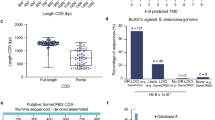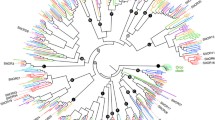Abstract
Candidate olfactory receptors of the moth Heliothis virescens were found to be extremely diverse from receptors of the fruitfly Drosophila melanogaster and the mosquito Anopheles gambiae, but there is one exception. The moth receptor type HR2 shares a rather high degree of sequence identity with one olfactory receptor type both from Drosophila (Dor83b) and from Anopheles (AgamGPRor7); moreover, in contrast to all other receptors, this unique receptor type is expressed in numerous antennal neurons. Here we describe the identification of HR2 homologues in two further lepidopteran species, the moths Antheraea pernyi and Bombyx mori, which share 86–88% of their amino acids. In addition, based on RT-PCR experiments HR2 homologues were discovered in antennal cDNA of the honey bee (Apis mellifera; Hymenoptera), the blowfly (Calliphora erythrocephala; Diptera) and the mealworm (Tenebrio molitor; Coleoptera). Comparison of all HR2-related receptors revealed a high degree of sequence conservation across insect orders. In situ hybridization of antennal sections from the bee and the blowfly support the notion that HR2-related receptors are generally expressed in a very large number of antennal cells. This, together with the high degree of conservation suggests that this unique receptor subtype may fulfill a special function in chemosensory neurons of insects.





Similar content being viewed by others
Abbreviations
- DIG:
-
digoxigenin
- RT:
-
reverse transcription
- TMD:
-
transmembrane domain
References
Akers RP, Getz WM (1993) Response of olfactory receptor neurons in honeybees to odorants and their binary mixtures, Comp Physiol A 173:169–185
Bouvier M (2001) Oligomerization of G-protein-coupled transmitter receptors. Nat Rev Neurosci 2:274–286
Chao TH, Ember JA, Wang M, Bayon Y, Hugli TE, Ye RD (1999) Role of the second extracellular loop of human C3a receptor agonist binding and receptor function. J Biol Chem 274:9721–9728
Clyne PJ, Warr CG, Freeman MR, Lessing D, Kim J, Carlson JR (1999) A novel family of divergent seven-transmembrane proteins: candidate odorant receptors in Drosophila. Neuron 22:327–338
Clyne PJ, Warr CG, Carlson JR (2000) Candidate taste receptors in Drosophila. Science 287:1830–1834
Devi AL (2001) Heterodimerization of G-protein-coupled receptors: pharmacology, signaling and trafficking. Trends Pharmcol Sci 22:532–537
Esslen J, Kaisssling K-E (1976) Zahl und Verteilung der antennalen Sensillen bei der Honigbiene (Apis mellifera). Zoomorphology 83:227–251
Fox AN, Pitts RJ, Robertson HM, Carlson JR, Zwiebel LJ (2001) Candidate odorant receptors from the malaria vector mosquito Anopheles gambiae and evidence of down-regulation in response to blood feeding. PNAS 98:14693–14697
Fox AN, Pitts RJ, Zwiebel LJ (2002) A cluster of candidate odorant receptors from the malaria vector mosquito Anopheles gambiae. Chem Senses 27:453–459
Gao Q, Chess A (1999) Identification of candidate Drosophila olfactory receptors from genomic DNA sequence. Genomics 60:31–39
Gao ZG, Chen A, Barak D, Kim SK, Muller CE, Jacobson KA (2002) Identification by site-directed mutagenesis of residues involved in ligand recognition and activation of the human A3 adenosine receptor. J Biol Chem 277:19056–19063
George SR, Fan T, Xie Z, Tse R, Tam V, Varghese G, O´Dowd BF (2000) Oligomerization of mu- and delta-opioid receptors: generation of novel functional properties. J Biol Chem 275:26128–26135
Hill CA, Fox AN, Pitts RJ, Kent LB, Tan PL, Chrystal MA, Cravchik A, Collins FH, Robertson HM, Zwiebel LJ (2002) G protein-coupled receptors in Anopheles gambiae. Science 298:176–178
Jordan BA, Devi LA (1999) G-protein-coupled receptor heterodimerization modulates receptor function. Nature 399:674–679
Kim J, Jiang Q, Glashofer M, Yehle S, Wess J, Jacobson KA (1996) Glutamate residues in the second extracellular loop of the human A2a adenosine receptor are required for ligand recognition. Mol Pharmacol 49:683–691
Krieger J, Gänßle H, Raming K, Breer H (1993) Odorant binding proteins of Heliothis virescens. Insect Biochem Mol Biol 23:449–456
Krieger J, Raming K, Dewer YME, Bette S, Conzelmann S, Breer H (2002) A divergent gene family encoding candidate olfactory receptors of the moth Heliothis virescens. Eur J Neurosci 16:619–628
Krogh A, Larsson B, Heijne G von, Sonnhammer ELL (2001) Predicting transmembrane protein topology with a hidden Markov model: application to complete genomes. J Mol Biol 305:567–580
Kumar S, Tamura K, Jakobsen IB, Nei M (2001) Molecular genetics analysis software. Bioinformatics 17:1244–1245
Lequin O, Bolbach G, Frank F, Convert O, Girault-Lagrange S, Chassaing G, Lavielle S, Sagan S (2002) Involvement of the second extracellular loop (E2) of the neurokinin-1 receptor in the binding of substance P. Photoaffinity labeling and modeling studies. J Biol Chem 277:22386–22394
Mombaerts P (1999) Seven-transmembrane proteins as odorant and chemosensory receptors. Science 286:707–711
Pfeiffer M, Koch T, Schroder H, Klutzny M, Kirscht S, Kreienkamp HJ, Hollt V, Schulz S (2001) Homo- and heterodimerization of somatostatin receptor subtypes. J Biol Chem 276:14027–14036
Raming K, Krieger J, Breer H (1990) Primary structure of a pheromone-binding protein from Antheraea pernyi: homologies with other ligand-carrying proteins. J Comp Physiol B 160:503–509
Robbins MJ, Calver AR, Filippov AK, Hirst WD, Russel RB, Wood MD, Nasir S, Couve A, Brown DA, Moss SJ, Pangalos MN (2001) GABA (B2) is essential for g-protein coupling of the GABA (B) receptor dimer. J Neurosci 21:8043–8052
Saitou N, Nei M (1987) The neighbor joining method: a new method for reconstructing phylogenetic trees. Mol Biol Evol 4:406–425
Sambrook JT, Fritsch EF, Maniatis F (1989) Molecular cloning (a laboratory manual). Cold Spring Habor Laboratory, New York
Scott K, Brady R, Cravchik A, Morozow P, Rzhetsky A, Zuker C, Axel R (2001) A chemosensory gene family encoding candidate gustatory and olfactory receptors in Drosophila. Cell 104:661–673
Sonnhammer ELL, Heijne G von, Krogh A (1998). A hidden Markov model for predicting transmembrane helices in protein sequences In: Glasgow J, Littlejohn T, Major F, Lathrop R, Sankoff D, Sensen C (eds) Proceedings of the 6th international conference on intelligent systems for molecular biology. AAAI Press, Menlo Park, CA, pp 175–182
Thompson JD, Higgins DG, Gibson TJ (1994). CLUSTAL W: improving the sensitivity of progressive multiple sequence alignment through sequence weighting, position specific gap penalties and weight matrix choice. Nucleic Acids Res 22:4673–4680
Vosshall LB, Amrein H. Morozow PS, Rzhetsky A, Axel R (1999) A spatial map of olfactory receptor expression in the Drosophila antenna. Cell 96:725–736
Vosshall LB, Wong AM, Axel R (2000) An olfactory sensory map in the fly brain. Cell 102:147–159
Acknowledgements
This work was supported by the Bayer CropScience AG Monheim and by grants from the Deutsche Forschungsgemeinschaft as part of the Trilateral German-Israeli-Palestinian Research program. We thank Gesa Dreesman and Thomas Gohl for untiring and excellent technical assistance and Sidonie Conzelmann for expert help with in situ hybridizations. The experiments comply with the Principles of Animal Care of the National Institute of Health and with the German laws for animal protection. Data deposition: the sequences reported in this paper have been deposited in the EMBL date base (accession nos.: AperR2=AJ555486; BmorR2=AJ555487; AmelR2=AJ555537; CeryR2=AJ555538 ; TmolR2=AJ555539).
Author information
Authors and Affiliations
Corresponding author
Rights and permissions
About this article
Cite this article
Krieger, J., Klink, O., Mohl, C. et al. A candidate olfactory receptor subtype highly conserved across different insect orders. J Comp Physiol A 189, 519–526 (2003). https://doi.org/10.1007/s00359-003-0427-x
Received:
Revised:
Accepted:
Published:
Issue Date:
DOI: https://doi.org/10.1007/s00359-003-0427-x




